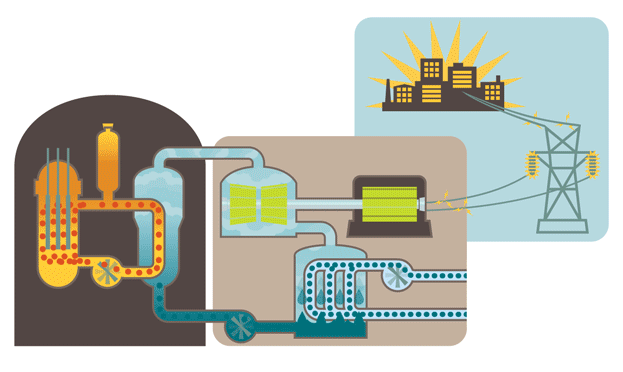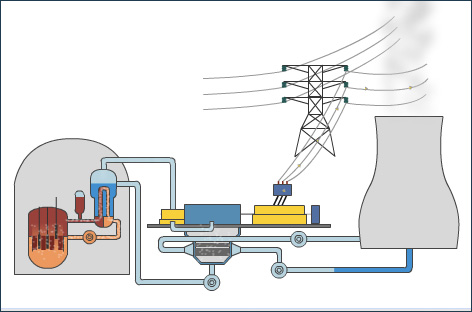(nuclear power)
The general form of electrical energy production in nuclear power plants
Researcher and author: Dr. ( Afshin Rashid)


Note: The general form of electric energy production in nuclear power plants is the same as in thermal power plants, with the difference that the source of heat production is not fossil fuel and the energy required to produce steam to turn the turbine is obtained from atomic interactions in the reactor.
Usually, the energy resulting from atomic interactions in the reactor is transferred to a fluid, which can be directed directly to the turbine or heat another fluid by passing through the heat exchanger and finally turn the necessary water into steam and use it. direct to the turbine. In the early nuclear reactors, the primary conveying fluid was water, which was directly directed to the turbine after turning into steam, but in today's technology, to enable more control over atomic interactions and reduce the risks caused by interactions In a closed circuit, the intermediate fluid transfers the heat produced in the reactor to water in a separate heat exchanger and turns it into steam.
Atomic interactions are done in two ways:
A) Atomic fission or fracture:
In this method, heavy elements are converted into light elements through atomic interactions and release energy. In this case, heavy elements release their internal energy by losing neutrons and reducing their weight. This process is used in existing nuclear power plant reactors
b) Atomic welding or fusion:
In this method, light elements are transformed into heavier elements by absorbing neutrons, and at the same time as they lose a small part of their weight, they release a part of their internal energy.

If a uniform fuel of uranium-238 or plutonium-239 is used in a reactor, a nuclear explosion will occur due to the uncontrollable increase in the number of nuclear fissions due to the chain process. But the chain process will not cause a nuclear explosion in a reactor, because the number of fissions in the reactor will not be large enough to cause an explosion, and this is due to the low degree of enrichment of the fuel of nuclear reactors. Natural uranium contains a small percentage (less than 1%) of uranium-235 and the rest is uranium-238 (because uranium-238 is not fissile). Most reactors of nuclear power plants use uranium with an enrichment percentage between 3% and 4%. If the material surrounding the fuel is composed of light elements , more energy is lost as a result of the neutron collision with those materials. which is the best and most available material for reactors . (D2O) and thermal heavy water (H2O), normal water If normal distilled water is used around the fuel rods of a nuclear reactor, the neutrons produced after 19 collisions can reach thermal energy and this amount for heavy water It will be 35 times, but at the same time, ordinary water absorbs a large amount of neutrons compared to heavy water, which will slow down further reactions , because only uranium 235 isotopes are able to react with thermal neutrons . Therefore, the absorption of neutrons causes the amount of the next reaction to decrease and the reactor to shut down. For this purpose, the amount of isotope 235 in The nuclear fuel goes up so that the thermal neutron collides with it before being absorbed by the water and the reaction of the nuclei takes place. As a result, there is a need to enrich uranium. But because the percentage of neutron absorption by heavy water is much lower than normal water. Therefore, if we want to use normal uranium in the reactor, as a result , heavy water should be accumulated around the fuel rods, so as to slow down the speed of neutrons and without absorbing it, it is possible to encounter and absorb thermal neutrons by uranium 235.

Conclusion:
The general form of electric energy production in nuclear power plants is the same as in thermal power plants, with the difference that the source of heat production is not fossil fuel, and the energy required to produce steam to turn the turbine is obtained from atomic interactions in the reactor.
Researcher and author: Dr. ( Afshin Rashid)
Specialized doctorate in nano-microelectronics





